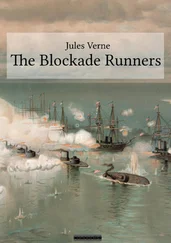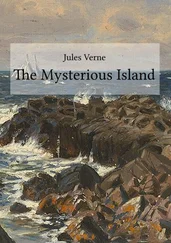“Yes; that’s where Parry disembarked his provisions from his ship, and, if I remember rightly, the roof of his tent was a topsail.”
“Everything must be greatly changed since 1825!”
“Not so much as any one might think. John Ross owed the health and safety of his crew to that fragile habitation in 1829. When the Prince Albert sent an expedition there in 1851, it was still existing; Captain Kennedy had it repaired, nine years ago now. It would be interesting to visit it, but Hatteras isn’t in the humour to stop!”
“I daresay he is right, Mr. Clawbonny; if time is money in England, here it is life, and a day’s or even an hour’s delay might make all the difference.”
During the day of Thursday, the 1st of June, the Forward cut across Creswell Bay; from Fury Point the coast rose towards the north in perpendicular rocks three hundred feet high; it began to get lower towards the south; some snow summits looked like neatly-cut tables, whilst others were shaped like pyramids, and had other strange forms.
The weather grew milder during that day, but was not so clear; land was lost to sight, and the thermometer went up to thirty-two degrees; seafowl fluttered about, the flocks of wild ducks were seen flying north; the crew could divest themselves of some of their garments, and the influence of the Arctic summer began to be felt. Towards evening the Forward doubled Cape Garry at a quarter of a mile from the shore, where the soundings gave from ten to twelve fathoms; from thence she kept near the coast as far as Brentford Bay. It was under this latitude that Bellot Strait was to be met with; a strait the existence of which Sir John Ross did not even guess at during his expedition in 1828; his maps indicated an uninterrupted coastline, whose irregularities he noted with the utmost care; the entrance to the strait must therefore have been blocked up by ice at the time. It was really discovered by Kennedy in April, 1852, and he gave it the name of his lieutenant, Bellot, as “a just tribute,” he said, “to the important services rendered to our expedition by the French officer.”
CHAPTER XVI
THE MAGNETIC POLE
Table of Contents
Hatteras felt his anxiety increase as he neared the strait; the fate of his voyage depended upon it; up till now he had done more than his predecessors, the most fortunate of whom, McClintock, had taken fifteen months to reach this part of the Polar Seas; but it was little or nothing if he did not succeed in clearing Bellot Strait; he could not retrace his steps, and would be blocked up till the following year.
He trusted the care of examining the coast to no one but himself; he mounted the crow’s nest and passed several hours there during the morning of Saturday. The crew perfectly understood the ship’s position; profound silence reigned on board; the engine slackened steam, and the Forward kept as near land as possible; the coast bristled with icebergs, which the warmest summers do not melt; an experienced eye alone could distinguish an opening between them. Hatteras compared his maps with the land. As the sun showed himself for an instant towards noon, he caused Shandon and Wall to take a pretty exact observation, which was shouted to him. All the crew suffered the tortures of anxiety for half the day, but towards two o’clock these words were shouted from the top of the mizenmast:
“Veer to the west, all steam on.”
The brig instantly obeyed; her prow was directed towards the point indicated; the sea foamed under the screws, and the Forward , with all speed on, entered between two ice-streams. The road was found, Hatteras descended upon deck, and the ice-master took his place.
“Well, captain,” said the doctor, “we are in the famous strait at last.”
“Yes,” answered Hatteras, lowering his voice; “but getting in isn’t everything; we must get out too,” and so saying he regained his cabin.
“He’s right,” said the doctor; “we are here in a sort of mousetrap, with scarcely enough space for working the brig, and if we are forced to winter in the strait!… Well, we shan’t be the first that have had to do it, and they got over it, and so shall we.”
The doctor was not mistaken. It was in that very place, in a little sheltered harbour called Kennedy Harbour by McClintock himself, that the Fox wintered in 1858. The high granite chain and the steep cliffs of the two banks were clearly discernible.
Bellot Strait is seventeen miles long and a mile wide, and about six or seven fathoms deep. It lies between mountains whose height is estimated at 1,600 feet. It separates North Somerset from Boothia Land.
It is easy to understand that there is not much elbow-room for vessels in such a strait. The Forward advanced slowly, but it did advance; tempests are frequent in the strait, and the brig did not escape them; by Hatteras’s order all sails were furled; but, notwithstanding all precautions, the brig was much knocked about; the waves dashed over her, and her smoke fled towards the east with astonishing rapidity; her course was not certain amongst the moving ice; the barometer fell; it was difficult to stop on deck, and most of the men stayed below to avoid useless suffering.
Hatteras, Johnson, and Shandon remained on the poop in spite of the gales of snow and rain; as usual the doctor had asked himself what would be the most disagreeable thing he could do, and answered himself by going on deck at once; it was impossible to hear and difficult to see one another, so that he kept his reflections to himself. Hatteras tried to see through the fog; he calculated that they would be at the mouth of the strait at six o’clock, but when the time came all issue seemed closed up; he was obliged to wait and anchor the brig to an iceberg; but he stopped under pressure all night.
The weather was frightful. The Forward threatened to break her chains at every instant; it was feared that the iceberg to which they were anchored, torn away at its base under the violent west wind, would float away with the brig. The officers were constantly on the lookout and under extreme apprehension; along with the snow there fell a perfect hail of ice torn off from the surface of the icebergs by the strength of the wind; it was like a shower of arrows bristling in the atmosphere. The temperature rose singularly during this terrible night; the thermometer marked fifty-seven degrees, and the doctor, to his great astonishment, thought he saw flashes of lightning in the south, followed by the roar of far-off thunder that seemed to corroborate the testimony of the whaler Scoresby, who observed a similar phenomenon above the sixty-fifth parallel. Captain Parry was also witness to a similar meteorological wonder in 1821.
Towards five o’clock in the morning the weather changed with astonishing rapidity; the temperature went down to freezing point, the wind turned north, and became calmer. The western opening to the strait was in sight, but entirely obstructed. Hatteras looked eagerly at the coast, asking himself if the passage really existed. However, the brig got under way, and glided slowly amongst the ice-streams, whilst the icebergs pressed noisily against her planks, the packs at that epoch were still from six to seven feet thick; they were obliged carefully to avoid their pressure, for if the brig had resisted them she would have run the risk of being lifted up and turned over on her side. At noon, for the first time, they could admire a magnificent solar phenomenon, a halo with two parhelia; the doctor observed it, and took its exact dimensions; the exterior bow was only visible over an extent of thirty degrees on each side of its horizontal diameter; the two images of the sun were remarkably clear; the colours of the luminous bows proceeded from inside to outside, and were red, yellow, green, and very light blue—in short, white light without any assignable exterior limit. The doctor remembered the ingenious theory of Thomas Young about these meteors; this natural philosopher supposed that certain clouds composed of prisms of ice are suspended in the atmosphere; the rays of the sun that fall on the prisms are decomposed at angles of sixty and ninety degrees. Halos cannot, therefore, exist in a calm atmosphere. The doctor thought this theory very probable. Sailors accustomed to the boreal seas generally consider this phenomenon as the precursor of abundant snow. If their observation was just, the position of the Forward became very difficult. Hatteras, therefore, resolved to go on fast; during the remainder of the day and following night he did not take a minute’s rest, sweeping the horizon with his telescope, taking advantage of the least opening, and losing no occasion of getting out of the strait.
Читать дальше












